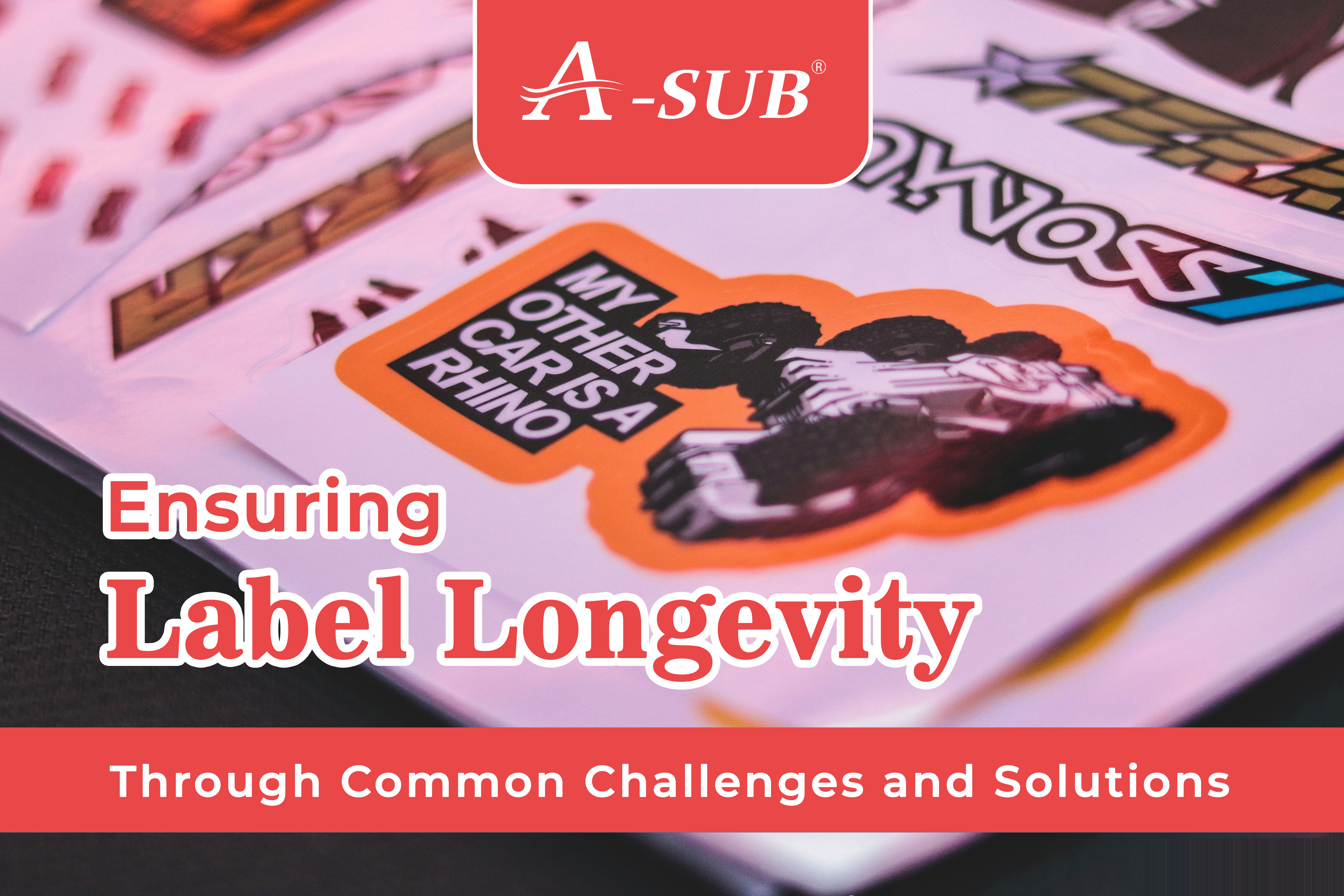This article aims to outline effective strategies for maintaining label quality throughout the supply chain. The key focus is addressing common issues that labels may encounter during distribution, warehouse storage and the projected product shelf life. With proper solutions and best practices, brands can ensure their labels persist in prime condition from the production line to the store shelf and beyond and continuing to fulfill their intended purpose.
Introduction
Successful supply chain management relies on labels maintaining their quality from production through distribution and the product lifecycle. However, issues sometimes arise during interim storage that can impact label performance if not addressed properly.
This article discusses three such challenges - changes in paper backing, excess adhesive migration and hot melt adhesive discoloration. Understanding their root causes allows prevention strategies to be established, protecting label integrity where it matters most - on store shelves engaging customers. Section one outlines how variations in temperature and humidity can cause paper shrinkage. Section two explains why controlling adhesive quantities and containment is key. And section three explores how light exposure contributes to hot melt adhesive degradation over long periods. With suitable controls for each hazard area, label printers can safeguard their product investment throughout the supply chain.
Challenge 1: Shrinking of Paper Backing

●Ink capacity
For factory, try buying an ink that has a larger size to accommodate a big amount of ink Because of the large orders. Only if you need this and work heavily. This will save your time as it will not need ink refilling again and again.
●Causes of paper shrinking due to temperature/humidity changes
The storage environment plays a crucial role in a paper's dimensional stability over time. Paper is highly sensitive to fluctuations in temperature and humidity, which can induce subtle changes in moisture content within fibers. When temperatures rise, paper absorbs moisture from the air, causing fibers to swell. Conversely, as temperatures drop, moisture is released from the paper as water evaporates from its fibers. Such variability in environmental conditions leads to subtle shrinkage or expansion of the material as its moisture level responds. Exposure to high heat similarly increases the risk of moisture loss already within the paper, resulting in shrinkage. Maintaining consistent temperature and humidity levels during storage and transport is therefore vital to prevent fluctuations that induce dimensional changes in paper over prolonged periods.
●Resulting problems like label misalignment
Shrinkage of the paper backing can directly influence critical label qualities. As the material contracts under low humidity, its dimensions decrease from the original production size. This mismatch pulls any printed graphics out of registration, distorting their intended placement and design within the label. Edge lifting is another potential issue, where shrinkage induces stress on adhesive bond lines causing outer label edges to peel from the package or product. Both misaligned graphics and edge lifting negatively impact the appearance and quality of labeled items in meaningful ways. Maintaining dimensional stability of the paper substrate over time is therefore important to preserve the visual cohesion between label design and containing surfaces from factory to final sale.
●Solution: Use papers with higher weather resistance
A-sub has formulated papers with improved dimensional stability against variations in temperature and moisture. Through enhanced fiber characteristics, these weather-resistant materials are able to withstand subtle water loss without significant warping or binding of the sheet structure from shrinkage. When humidity decreases or temperatures rise briefly during storage and transport, the paper better maintains its original shape compared to conventional substrates. This enhanced resistance to temporary environmental fluctuations helps retain the intended label design registration and reduces issues like edge lifting over time. A-sub’s modified compositions thus deliver more robust labeling materials that can withstand the realities of the supply chain in transit to end users.
●Solution: Control backing composition
The paper manufacturing process allows for compositional nuances that boost dimensional stability. Variables such as the ratio of cellulose fibers and their treatments alter how the sheet responds to moisture fluctuations. Through tighter quality control of papermaking, the interplay between these compositional factors can be optimized to achieve enhanced reliability in the paper's ability to retain its shape over time. Precisely modulating the plant-derived materials during production facilitates a sheet structure that exhibits greater resistance to the impacts of environmental changes common throughout distribution. With robust quality assurance, labels can be manufactured using substrates tailored for reliable dimensional performance.
●Solution: Store in moisture-barrier bags
Immediately packaging labels within multi-layer barrier bags after production provides an insulating buffer against absorbing or releasing moisture during subsequent storage and shipping. By enclosing the labels, their immediate surroundings can be separated from ambient humidity and temperature fluctuations conducive to dimensional changes. Effectively, barrier packaging creates a stable microclimate controlling the label material's exposure to external environmental variability throughout distribution. This protective step safeguards the paper substrates' dimensions against alterations before conversion and maximizes the likelihood labels will maintain precision throughout downstream processing.
Challenge 2: Excess Adhesive Bleed

●Cause of bleed being too much glue applied during labeling
Precise adhesive metering plays a pivotal role in avoiding bleed issues down the line. Applying more than the needed amount during labeling raises the risk of bleed emerging over time as excess glue breaks down under heat and pressure stresses encountered throughout distribution. Even a minor surplus in dispensed adhesive volume may not cause immediate bleed but could manifest later if labels are not properly stored. Consistent control of the glue application process helps ensure labeling occurs within specified parameters and reduces the chance leftover adhesive will destabilize. Tight regulation of depositing adhesive is thus important to support long-term clarity of packaged goods.
●Problems such as adhesive seeping over time
Excess adhesive increases the risk of surface breaches developing over time. Stored labels bearing too much glue face degradation, as the additional material may slowly detach from the applied region, outwardly migrating in an unconstrained bloom. This leads to smearing and marred appearances on both labels and products through non-uniform discoloration and loss of print clarity. With bleed compromising visual cohesion, such affected labeling can no longer fulfill its purpose and may require replacement. Precise metering during application remains key to avoiding potential issues down the line from destabilized glue reservoirs finding pathways to spread.
●Solution: Carefully monitor glue volumes
Maintenance of specified adhesive parameters demands consistent verification. Through regular checks of dispenser calibration aligned with technical specifications, appropriate metering can be confirmed and corrected if needed. Ensuring deposited volumes always conform to prescribed levels prevents excess glue issues. Close monitoring and calibration adjustment as required allows any applicator drift to be addressed before documented requirements are surpassed. This supports sustainability of optimal labeling performance by safeguarding precise metering assuring cohesive product presentation.
●Solution: A-sub’s labels undergo QC to prevent bleed issues
A-sub subjects its labels to rigorous testing that confirms durability. A multi-point inspection process subjects samples to various conditions like heat to verify resistance to bleed during storage and shipment. Strict quality control ensures consistent gluability remains uncompromised. Through meticulous testing under simulated distribution scenarios and maintenance of standards, A-sub verifies labels can withstand real-world conveyance without functional or visual degradation. This helps guarantee labels arrive at end use in their intended state, bolstering customer satisfaction.
Challenge 3: Hot Melt Adhesive Discoloration

●Cause of discoloration being extended light exposure
For labels utilizing hot melt adhesive systems, prolonged exposure poses challenges. Unshielded illumination encountered in warehousing or displays brings accumulation risk, as adhesives designed for such systems face potential photo-oxidative impacts. Whether ultraviolet rays in sunlight or artificial visible lighting, unfiltered light carries energy that can degrade the adhesive molecular structure over time through oxidation. As a consequence of these photochemical reactions, discoloration often emerges due to structural changes wrought by the intrusive photons. Proper protection counters light's cumulative effects on adhesive elements striving for integrity throughout product lifecycles.
●Issue of adhesives yellowing and darkening over time
Gradual discoloration arises as the main consequence of photolytic breakdown. With increasing hours of light exposure, the adhesive's appearance undergoes a progressive shift as it yellows or darkens. This visual change can detract from the aesthetics of labeled products and reduce consumer appeal over the lifespan. In more extreme cases, such discoloration may compromise the integrity of the bond formed by the adhesive.
●Solution: A-sub's Advanced Hot Melt Adhesives
To confront prolonged storage periods’ hot melt adhesive discoloration challenge, A-sub significantly invested in next-generation hot melt technology research and development. Through their own adhesive production facilities, advanced hot melt formulations were devised demonstrating tremendously enhanced lightfastness against conventional thermoplastic standards.
While the specially designed lightfast adhesives involve elevated unit production expenditure, extensive resilience testing confirmed their aptitude to forestall yellowing even after thousands of sunlight exposure hours. This offers tangible customer benefits by making certain labeled items on shelves or in warehouses retain intended branding manifestation throughout projected shelf life and stockpile durations.
A-sub's proprietary lightfast solution supplies trustworthy aid for applications where extended light may compromise general adhesive systems. Backed by adhesive professionals and rigorous process administration, label manufacturers and transforms can rely on these adhesives to safeguard quality reputation throughout distribution and storage years.
Conclusion
Maintaining labeled items' intended excellence, functionality and visual appeal from generation to consumer has constantly been a premier concern for A-sub as a labeling manufacturer and brand owner. However, realizing this objective necessitates a meticulous comprehension of potential issues labels may face during interim storage and treatment. As analyzed in this article, markings are prone to dimensional shifts from climatic fluctuations, adhesive degradation from excessive light vulnerability, and other stresses under uncontrolled stockpiling. Taking preemptive steps to mitigate recognized dangers can effectively preserve labeling substance integrity in the long run.
At A-sub, we are committed to safeguarding labeling substance integrity by proactively implementing preventive solutions to the common challenges addressed, such as paper backing contraction owing to temperature and humidity variations or discoloration of hot melt adhesives from photo-oxidation. Whether specifying paper compositions better tailored for distribution state or enforcing strict quality monitoring over adhesive amounts from the early planning periods, addressing root explanations is gainful.
We also furnish personalized direction taking into account different merchandise varieties and supply chain environments, with recommendations on label selection, material optimization and stockpiling greatest practices. This aids labels in fulfilling their use objective within projected life cycles. We welcome all sector clients to seek advice from A-sub regarding their distinct labeling necessities as we work together towards quality labeling solutions.






